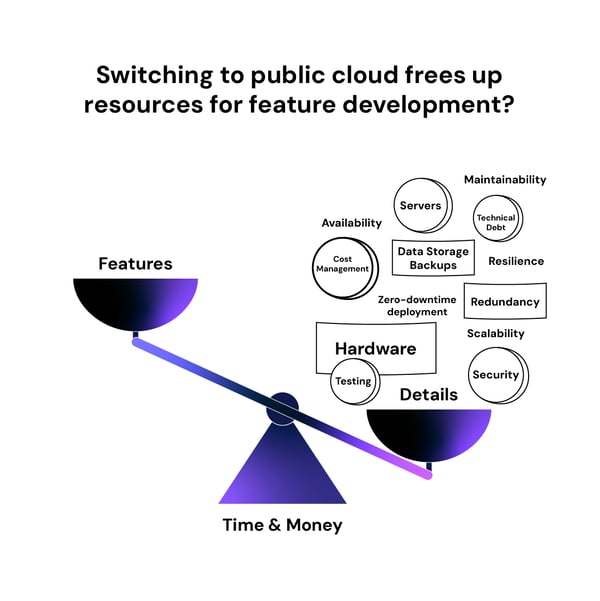Unpacking our preference for Public Cloud Architecture
Visma Connect champions the power of the public cloud.
At Visma Connect, best-in-class technology is at the core of what we do. Our journey began with virtualization, then evolved to private and finally public cloud. This strategic shift has been instrumental in shaping our company and the innovative solutions we offer today. We firmly believe in the benefits of the public cloud for our customers. In the blog post, Overcoming Cloudwatervrees: Taking the Plunge with Public Cloud, we explored the key reasons behind this preference. Now, we'll delve deeper into the technical specifications that solidify our public cloud advocacy.
In this blog
- Shared Security and Enhanced Protection
- Data Sovereignty & GDPR compliance
- Avoiding Vendor Lock-in
- Managed Services
- Serverless Technology for Dynamic Workloads
- Elastic Scaling
- Greener Footprint
- Unlocking Potential with the Public Cloud
Read further below 👇
Shared Security and Enhanced Protection
In a public cloud environment, security becomes a shared responsibility. Cloud service providers (CSPs) manage the security of the underlying infrastructure, leveraging economies of scale. Millions of servers, many containing highly sensitive data, run on this platform. Consequently, CSPs invest heavily in security measures, spreading the costs across their vast customer base and making it significantly more cost-effective than individual customer investments.
The Visma Group, awarded as the #1 Cloud Computing Company of 2024, recognizes the user's responsibility to secure their own systems within the public cloud environment. To that end, we at Visma Connect – as one of its subsidiaries, follow the "Visma Cloud Delivery Model" (VCDM). VCDM is a methodology for bringing software to the cloud securely and efficiently. It prioritizes security, legal compliance, and continuous deployment practices within the system. VCDM compliance ensures the security of our systems and automatically qualifies them for certifications like ISO27001 or ISAE 3402 Type II, eliminating the need for additional external audits.
Data Sovereignty & GDPR compliance
There is a growing emphasis in software development on data sovereignty, which refers to the right of an individual or a group to control and maintain their own data. This is reinforced by European regulatory initiatives that are shifting data management from a "push" to a "pull" model. When data is "pushed" to various systems, unnecessary copies are often created.
Going forward, the owner of the data will have the right to:
- Ensure only the latest version of their data is used.
- Grant or revoke access to their data.
- Correct any inaccuracies in their data.
These changes address concerns around data processing in the public cloud, making it a more secure and compliant environment for European organizations. Systems built on a public cloud can also ensure compliance with the General Data Protection Regulation (GDPR) by choosing where the data is stored and how it is processed.
VCDM compliance requires data localization within the EU and EEA, as well as adhering to strict data protection laws in line with GDPR. Consequently, Visma Connect uses European data centers and keeps abreast of the latest trends in data laws and regulations when it comes to building or upgrading our software architecture.
Avoiding Vendor Lock-in
Many organizations fear getting locked into a specific platform or software solution. Thankfully, containerization has standardized much of the software landscape, providing flexibility and simplifying migration between providers. Planning ahead can also make this process easier. For example, DocumentDB supports a subset of MongoDB features, allowing you to start with DocumentDB without worrying about a costly migration if you need to switch later. This is why, at Visma Connect, we prioritize exit strategies. We proactively identify potential replacements for every component we use, ensuring your long-term flexibility and freedom of choice.
Managed Services
Public cloud platforms offer a wealth of pre-installed, off-the-shelf managed services that streamline development and deployment. For example:
-
Faster deployment - Managed services eliminate the need for manual installation and configuration of middleware components before starting on the application layer, significantly accelerating development and reducing time-to-market.
-
Reduced costs - Services such as object storage have shifted from being product first to readily available as commodities.
-
Customer centric - Leveraging these services makes it easier to create customer facing functionality and fail fast if it doesn’t meet their needs.
-
Less time on maintenance - Finally, as managed services are managed, you don’t need to patch them and keep them up to date. This speeds up deployment and time-to-value, freeing up capacity to work on enhancing functionality.

Serverless Technology for Dynamic Workloads
Serverless technology is optimal for applications with fluctuating traffic volumes. When the volume of traffic on your system is low, using serverless technology can be cheaper than running a server 24/7. Unlike traditional servers that run continuously, serverless services operate on-demand. They are optimized to spin up quickly and can scale out to millions of requests when needed.
Some AWS services can run as both serverless and non-serverless. This is important because as volumes grow, a tipping point might be reached where serverless technologies are no longer cheaper, and traditional servers can become more economical.
Elastic Scaling
Both public and private clouds offer elastic scaling, but the public cloud often provides a significant edge. Public cloud providers offer a more comprehensive range of readily available resources and automated features that simplify scaling based on your workload. This eliminates the need for pre-determined, fixed capacity based on peak usage. With elastic scaling, resources can be dynamically adjusted to meet volatile demand patterns. This translates to two key benefits for your business:
-
Reduced costs: You only pay for the resources you use, eliminating the waste associated with over-provisioning in a private cloud environment.
-
Reduced emissions: By minimising unused resources, elastic scaling helps lower your CO2 emissions.
Greener Footprint
Compared to traditional data centres, native cloud services offer significantly higher server utilisation rates. This means less idle server time and, consequently, lower energy consumption and reduced carbon emissions. Public cloud providers are also leading the charge towards sustainability. Major players have set ambitious goals aligned with the Paris Agreement, aiming to achieve net-zero or even carbon-negative operations. For instance, Google strives to power its data centres entirely with carbon-free energy by 2030.
Unlocking Potential with the Public Cloud
The public cloud empowers both users and developers with a wealth of advantages. From automatic updates and cost-efficiency to enhanced security and scalability, the benefits extend to a broader range of organisations thanks to advancements in public cloud security. At Visma Connect, we remain committed to shaping the future with technology, and the public cloud serves as a cornerstone of our innovation. Ready to explore how the public cloud can transform your business?
Would you like to know more?
Don't be a stranger—if you'd like to know more about our approach or share your thoughts on leveraging the public cloud, we're here to help. Contact us today!



